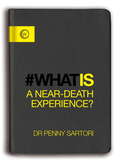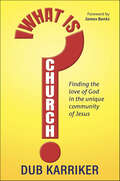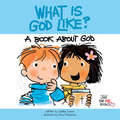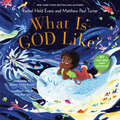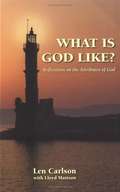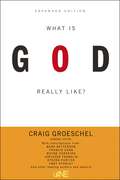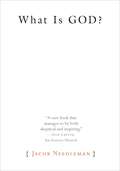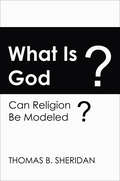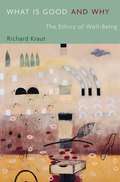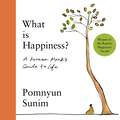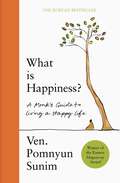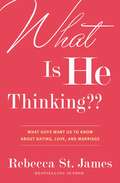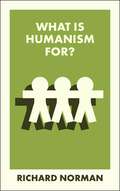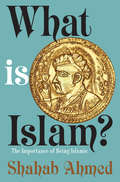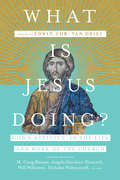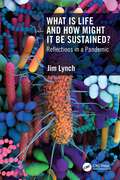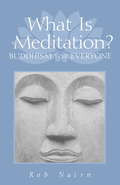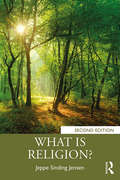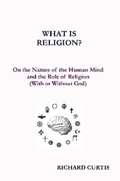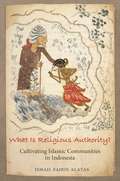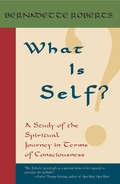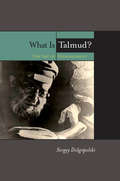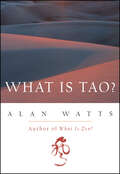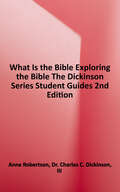- Table View
- List View
What Is A Near Death Experience?
by Dr Penny SartoriDeath is the only certainty in life yet many people shy away from thinking about it until something drastic happens such as the diagnosis of a life-threatening illness, or the sudden death of a loved one, which can throw us into turmoil. Yet, paradoxically, contemplating death and the frequently-experienced phenomenon of near-death experiences (NDEs) - which are so little recognised and supported within the traditional medical environment - can really help alter our relationship with death and release us from the fear that often surrounds it.After an insightful introduction about why the subject of NDEs is so worth exploring, each chapter in this book addresses a key question: What are the Characteristics of an NDE, and are there different types? Are all NDE experiences pleasant, or can some be distressing? Who has NDEs and under what circumstances do they occur? How do they affect the people who have them, and how can this change their lives? How can NDEs be scientifically explained - aren't they just hallucinations? What can we learn from NDEs, and can they change our attitude to life and death? Can a greater understanding of NDEs lead to an evolution in our consciousness and an enhanced sense of spirituality?As such, this book really brings readers on an exploratory journey through the world of NDEs, challenging preconceptions about what they are and the impact they can have, encouraging us to accept and feel empowered by death, rather than living in fear of it, and giving us useful insights about life along the way.From the Trade Paperback edition.
What Is Church?: Finding the love of God in the unique community of Jesus
by Dub KarrikerAn informative and emotional voyage of exploration for those active, hurt by, leaving, looking at or curious about the Church.Amid worldwide upheaval, believers and non-believers alike are asking profound questions. One can’t help but do that when something or someone they have depended on for guidance, structure, community, comfort, identity, and meaning has been exposed to the light, shaken to the core, and found to be unreliable and untrustworthy. What is Church? is for believers in Jesus, as well as those deconstructing their faith, seekers, skeptics, and opponents, to inform and help resolve the innate longing for answers, truth, meaning, and belonging by plumbing the depths of divinely revealed knowledge.Drawing on scripture, history, personal relationships, experience, and a deep love for Jesus and the Church, Dub Karriker shares valuable insights that provide a different perspective on the Church and its role in the past, present, and future. Rather than walking a well-worn path of two thousand years of best intentions and church misdeeds, Karriker reveals the Church as intended by its founders, Jesus and His Apostles. No matter what your relationship is with the Christian community, What is Church? is a fascinating, soul-stirring journey of inquiry and answers.
What Is God Like?
by Anne Fitzgerald Cynthia GeisenGod is a mystery and, although our attempts to define or explain God always fall short, we can describe our experiences of God. In What Is God Like?: A Book about God . . . Just for Me!, author Cynthia Geisen introduces children to a way of getting to know God that helps them understand all the ways God can be found in the world around us--the God who is so eagerly waiting to be discovered.
What Is God Like?
by Matthew Paul Turner Rachel Held Evans#1 NEW YORK TIMES BESTSELLER • The late, beloved Rachel Held Evans answers many children's first question about God in this gorgeous picture book, fully realized by her friend Matthew Paul Turner, the bestselling author of When God Made You.Children who are introduced to God, through attending church or having loved ones who speak about God, often have a lot of questions, including this ever-popular one: What is God like? The late Rachel Held Evans loved the Bible and loved showing God&’s love through the words and pictures found in that ancient text. Through these pictures from the Bible, children see that God is like a shepherd, God is like a star, God is like a gardener, God is like the wind, and more. God is a comforter and support.And whenever a child is unsure, What Is God Like? encourages young hearts to &“think about what makes you feel safe, what makes you feel loved, and what makes you feel brave. That's what God is like.&”
What Is God Like? Reflections on the Attributes of God (2nd edition)
by Lloyd Mattson Len CarlsonIn a day of often-airy theology, it is refreshing to find a straightforward declaration of the nature of the God of the Bible set forth in language that even a child can grasp. Len Carlson was a hard-working pastor preacher, who loved his people and Jesus.
What Is God Really Like? Expanded Edition
by Craig GroeschelCraig Groeschel (www.lifechurch.tv) and his church have hosted an international multichurch campaign called One Prayer, a month-long concerted focus on unifying the many different, diverse churches participating by praying together and serving their local communities.In 2009, One Prayer campaign attracted over two thousand churches and over one million church members. Many of these churches are high-profile evangelical churches with pastors who are also successful authors and speakers. The campaign continues to attract interest from more and more churches and ministries. The 2010 campaign, scheduled for June, is expected to grow by 50 percent. This compilation book features chapters by seventeen passionate church leaders, including Andy Stanley, Francis Chan, Jentezen Franklin, Perry Noble, Steven Furtick, and others.
What Is God?
by Jacob NeedlemanIn his most deeply personal work, religious scholar Needleman cuts a clear path through today's clamorous debates over the existence of God, illuminating an entirely new way of approaching the question of how to understand a higher power. I n this new book, philosopher Jacob Needleman- whose voice and ideas have done so much to open the West to esoteric and Eastern religious ideas in the twentieth and twenty-first centuries-intimately considers humanity's most vital question: What is God? Needleman begins by taking us more than a half century into the past, to his own experience as a brilliant, promising, Ivyeducated student of philosophy-atheistic, existential, and unwilling to blindly accept childish religiosity. But an unsettling meeting with the venerated Zen teacher D. T. Suzuki, combined with the sudden need to accept a dreary position teaching the philosophy of religion, forced the young academician to look more closely at the religious ideas he had once thought dead. Within traditional religious texts the scholar discovered a core of esoteric and philosophical ideas, more mature and challenging than anything he had ever associated with Judaism, Christianity, and the religions of the East. At the same time, Needleman came to realize-as he shares with the reader-that ideas and words are not enough. Ideas and words, no matter how profound, cannot prevent hatred, arrogance, and ultimate despair, and cannot prevent our individual lives from descending into violence and illusion. And with this insight, Needleman begins to open the reader to a new kind of understanding: The inner realization that in order to lead the lives we were intended for, the very nature of human experience must change, including the very structure of our perception and indeed the very structure of our minds. In What Is God?, Needleman draws us closer to the meaning and nature of this needed change-and shows how our present confusion about the purpose of religion and the concept of God reflects a widespread psychological starvation for this specific quality of thought and experience. In rich and varied detail, the book describes this inner experience-and how almost all of us, atheists and "believers" alike, actually have been visited by it, but without understanding what it means and why the intentional cultivation of this quality of experience is necessary for the fullness of our existence.
What Is God?: Can Religion Be Modeled?
by Thomas B. SheridanAn eminent psychologist and engineer presents a provocative analysis of the concept of God through the lens of scientific inquiry.This is a study of the concept of God, not from the perspective of any religious tradition, but as a pervasive social phenomenon that has prevailed through the ages. An expert in engineering and applied psychology, author Thomas B. Sheridan offers unique perspective on the subject. In What Is God?, he asks whether the concept of God can be modeled in denotative language (much as modeling in science, medicine and modern professions) in contrast to connotative language (e.g., myth, metaphor, art and music). Sheridan adopts the assumption of model-based reality, as currently prevalent in physics and some branches of philosophy. That criterion means an entity can be called real for public discourse purposes only to the extent that a credible model can be made of what the entity is or how it works—as opposed to the private reality of thoughts, perceptions, or dreams. What follows is a truly provocative and enlightening through experiment with far-reaching implications.“It is rare to see the ultimate question of God as prime mover examined as a problem open to rigorous scientific inquiry. Thomas Sheridan has now done it with admirable clarity.” —Edward O. Wilson, Pulitzer Prize winning author of The Meaning of Human Existence
What Is Good and Why: The Ethics of Well-being
by Richard KrautWhat is good? How can we know, and how important is it? In this book Richard Kraut, one of our most respected analytical philosophers, reorients these questions around the notion of what causes human beings to flourish--that is, what is good for us. Observing that we can sensibly talk about what is good for plants and animals no less than what is good for people, Kraut advocates a general principle that applies to the entire world of living things: what is good for complex organisms consists in the maturation and exercise of their natural powers.
What Is Happiness: A Korean Monk's Guide to Life
by Pomnyun Sunim'When I ask people, "Are you happy?" in my talks, very few people say yes.'There are many things that seem to prevent us from being happy in our lives. Usually, things don't turn out the way we want them to. It could be unfulfilled goals, bad habits, a society that's built to benefit only those at the very top, or the loops of self-deprecation that many of us find ourselves falling into. But we can take control of our happiness, whatever life throws at us. We all have the right, and the ability, to be happy regardless of our situation.With his simple yet profound teachings, Buddhist monk Pomnyun Sunim shows us how to combat day-to-day anxiety, insecurity, anger, and discouragement. He explains why humans are prone to self-destruction, and redirects our focus to finding happiness.This book has touched countless lives and uplifted spirits in Korea, and it's time for the rest of the world to experience and understand exactly what is happiness.
What Is Happiness: A Monk's Guide to a Happy Life
by Pomnyun Sunim'When I ask people, "Are you happy?" in my talks, very few people say yes.'There are many things that seem to prevent us from being happy in our lives. Usually, things don't turn out the way we want them to. It could be unfulfilled goals, bad habits, a society that's built to benefit only those at the very top, or the loops of self-deprecation that many of us find ourselves falling into. But we can take control of our happiness, whatever life throws at us. We all have the right, and the ability, to be happy regardless of our situation.With his simple yet profound teachings, Buddhist monk Pomnyun Sunim shows us how to combat day-to-day anxiety, insecurity, anger, and discouragement. He explains why humans are prone to self-destruction, and redirects our focus to finding happiness.This book has touched countless lives and uplifted spirits in Korea, and it's time for the rest of the world to experience and understand exactly what is happiness.
What Is He Thinking??: What Guys Want Us to Know About Dating, Love, and Marriage
by Rebecca St. JamesIn WHAT IS HE THINKING??, Rebecca interviews a range of men from high-profile types to the guys next door, men that every woman can relate to. Although the interviews focus on single guys ages 20-35, Rebecca also includes words of wisdom from older mentors she respects who have been successfully married for years, such as her dad, life coach, and pastor. The men share their thoughts on topics like how women can respect themselves and the men in their lives, modesty, purity, taking it slow, friendship, letting guys lead, and more. This book gives them the floor to say what they would really like women to know. The men respond candidly to questions like: What is the most attractive quality to you in a woman? Is modesty truly attractive? Is neediness a turn-off? What do you find beautiful? How can we be dependent on God for our identity, not on you? How can we help you with boundaries physically? Rebecca also discusses her own dating life, speaking openly about the single life, her struggle with loneliness, and her hope for the future. She challenges women to see the men in their lives as brothers in Christ and to trust God with their dating lives.
What Is Humanism For? (What Is It For?)
by Richard NormanReligious belief is declining in many parts of the world, yet people still seek purpose in their lives and guidance on how to navigate life’s challenges. Humanism is a broad tradition of thought and action which encourages thinking for yourself about what to believe and accommodating diversity. What is the purpose of humanism in an increasingly secular world? Written by a pre-eminent authority in this field, this book shows how humanism’s purpose is to help people to meet their need to understand the world around them. Given the growing demand for humanist funerals, weddings and baby naming ceremonies, it will help both existing adherents and the “humanism-curious” to contextualise its potential role in making sense of their lives.
What Is Islam?
by Shahab AhmedWhat is Islam? How do we grasp a human and historical phenomenon characterized by such variety and contradiction? What is "Islamic" about Islamic philosophy or Islamic art? Should we speak of Islam or of islams? Should we distinguish the Islamic (the religious) from the Islamicate (the cultural)? Or should we abandon "Islamic" altogether as an analytical term?In What Is Islam?, Shahab Ahmed presents a bold new conceptualization of Islam that challenges dominant understandings grounded in the categories of "religion" and "culture" or those that privilege law and scripture. He argues that these modes of thinking obstruct us from understanding Islam, distorting it, diminishing it, and rendering it incoherent.What Is Islam? formulates a new conceptual language for analyzing Islam. It presents a new paradigm of how Muslims have historically understood divine revelation--one that enables us to understand how and why Muslims through history have embraced values such as exploration, ambiguity, aestheticization, polyvalence, and relativism, as well as practices such as figural art, music, and even wine drinking as Islamic. It also puts forward a new understanding of the historical constitution of Islamic law and its relationship to philosophical ethics and political theory.A book that is certain to provoke debate and significantly alter our understanding of Islam, What Is Islam? reveals how Muslims have historically conceived of and lived with Islam as norms and truths that are at once contradictory yet coherent.
What Is Jesus Doing?: God's Activity in the Life and Work of the Church
by Edwin Chr. Van DrielJesus is present here and now, Christians have always affirmed. But how are we to understand his present activity in a challenging, post-Christian context?What Is Jesus Doing?David FergussonDwight J. ZscheileScott J. HagleyCraig BarnesRoger OwensAnthony B. RobinsonWill WillimonAndrew RootJohn D. WitvlietNicholas WolterstorffAngela Dienhart HancockTrygve D. Johnson
What Is Life and How Might It Be Sustained?: Reflections in a Pandemic
by Jim LynchHow did the universe and life begin and what are the threats to people and the environment in a pandemic? This book is for anybody with interest in protecting life on the planet. Studies on the origin of life and scientific contributions to safeguarding the planet are examined in light of current thinking on climate change. A major focus is the spread of microbes, put in the context of environmental assessment and management, including descriptions of microbiomes and a consideration of the risks of genetic modifications. Professor Lynch shows how failure to control disease can lead to the collapse of any biotic population. To avoid this, the ethics of management of disease by biological control and by vaccination are discussed, at the practical level and in a moral theological context.
What Is Meditation?: Buddhism for Everyone
by Ron NairnWhat Is Meditation? explains the Buddhist worldview and the age-old practice it perfected to unfold our innate qualities of compassion, self-acceptance, and inner peace. Rob Nairn gives step-by-step instructions for beginning your own meditation practice, including three simple exercises--"Bare Attention," "Remaining in the Present," and "Meditation Using Sound"--to help get you started.
What Is Religion?
by Jeppe Sinding JensenStarting from the premise that religion is a human endeavour that can be analysed and compared across time and cultures, What Is Religion? brings the most up-to-date scholarship to bear on humankind’s most enduring creation. Religious belief is one of the most pervasive and ubiquitous characteristics of human society. Religion has influenced human lives since prehistoric times, shaping the world views of cultures from isolated tribes to vast empires. The book opens with a brief history of the idea of religion, then divides the study of religion into four essential topics – types, representations, practices and institutions – and concludes with a final, eye-opening chapter on religion today. Packed with case studies from a wide range of religions, past and present, What Is Religion? offers a very current, comprehensive, yet intellectually challenging, overview of the history, theories, practices and study of religion. Thoroughly updated throughout, this second edition provides an accessible, wide-ranging, engaging and concise book for undergraduate students in the study of religion. It is also invaluable for students of anthropology, history, psychology, sociology and theology as well as anyone interested in how and why humans became and continue to be religious.
What Is Religion?
by Richard CurtisIn this book Richard Curtis argues that religion is a universal human phenomenon regardless of content. In popular culture religion is understood to be belief in supernatural things but specialists in the field usually use a generic definition. Dr. Curtis, here, offers his theory of the nature of religion, which is open as to content (that is compatible with theistic and atheistic positions), based on the latest insights from Philosophy of Mind, the Social Sciences and the Cognitive Sciences.
What Is Religious Authority?: Cultivating Islamic Communities in Indonesia (Princeton Studies in Muslim Politics #84)
by Ismail Fajrie AlatasAn anthropologist's groundbreaking account of how Islamic religious authority is assembled through the unceasing labor of community building on the island of JavaThis compelling book draws on Ismail Fajrie Alatas's unique insights as an anthropologist to provide a new understanding of Islamic religious authority, showing how religious leaders unite diverse aspects of life and contest differing Muslim perspectives to create distinctly Muslim communities.Taking readers from the eighteenth century to today, Alatas traces the movements of Muslim saints and scholars from Yemen to Indonesia and looks at how they traversed complex cultural settings while opening new channels for the transmission of Islamic teachings. He describes the rise to prominence of Indonesia's leading Sufi master, Habib Luthfi, and his rivalries with competing religious leaders, revealing why some Muslim voices become authoritative while others don't. Alatas examines how Habib Luthfi has used the infrastructures of the Sufi order and the Indonesian state to build a durable religious community, while deploying genealogy and hagiography to present himself as a successor of the Prophet Muḥammad.Challenging prevailing conceptions of what it means to be Muslim, What Is Religious Authority? demonstrates how the concrete and sustained labors of translation, mobilization, collaboration, and competition are the very dynamics that give Islam its power and diversity.
What Is Religious Life? Questions Religious Are Asking
by Fr. Thomas DubayDubay answers questions to help people gain a clearer understanding of the theological dimensions of the religious life
What Is Self?: A Study of the Spiritual Journey in Terms of Consciousness
by Bernadette RobertsThe renowned contemporary mystic and author of The Experience of No-Self presents her philosophical treatise on the nature of Self and God. As a Carmelite nun, Bernadette Roberts pursued a life in union with God. She wrote compellingly about her contemplative spiritual journey in her memoirs The Experience of No-Self and The Path of No-Self. Now she builds on the wisdom she gained, exploring the ultimate consciousness that transcends self and experience. In What Is Self?, Ms. Roberts explains her conceptions of the ego, the self, and the revelations of the contemplative life. Deeply personal and profoundly spiritual, this latest effort puts all of Bernadette&’s insights into clearer and sharper perspective—as though her own journey has grown clearer with distance.
What Is Talmud?: The Art of Disagreement
by Sergey DolgopolskiTrue disagreements are hard to achieve, and even harder to maintain, for the ghost of final agreement constantly haunts them. The Babylonian Talmud, however, escapes from that ghost of agreement, and provokes unsettling questions: Are there any conditions under which disagreement might constitute a genuine relationship between minds? Are disagreements always only temporary steps toward final agreement? Must a community of disagreement always imply agreement, as in an agreement to disagree? What is Talmud? rethinks the task of philological, literary, historical, and cultural analysis of the Talmud. It introduces an aspect of this task that has best been approximated by the philosophical, anthropological, and ontological interrogation of human being in relationship to the Other-whether animal, divine, or human. In both engagement and disengagement with post-Heideggerian traditions of thought, Sergey Dogopolski complements philological-historical and cultural approaches to the Talmud with a rigorous anthropological, ontological, and Talmudic inquiry. He redefines the place of the Talmud and its study, both traditional and academic, in the intellectual map of the West, arguing that Talmud is a scholarly art of its own and represents a fundamental intellectual discipline, not a mere application of logical, grammatical, or even rhetorical arts for the purpose of textual hermeneutics. In Talmudic intellectual art, disagreement is a fundamental category. What Is Talmud? rediscovers disagreement as the ultimate condition of finite human existence or co-existence.
What Is Tao?
by Alan WattsAlan Watts — noted author and respected authority on Far Eastern thought — studied Taoism extensively, and in his final years moved to a quiet cabin in the mountains and dedicated himself almost exclusively to meditating and writing on the Tao. This new book gives us an opportunity to not only understand the concept of the Tao but to experience the Tao as a personal practice of liberation from the limitations imposed by the common beliefs within our culture. The philosophy of the Tao offers a way to understand the value of ourselves as free-willed individuals enfolded within the ever-changing patterns of nature. The path of the Tao is perhaps the most puzzling way of liberation to come to us from the Far East in the last century. It is both practical and esoteric, and it has a surprisingly comfortable quality of thought that is often overlooked by Western readers who never venture beyond the unfamiliar quality of the word Tao (pronounced "dow"). But those who do soon discover a way of understanding and living with the world that has profound implications for us today in so-called modern societies. The word Tao means the Way — in the sense of a path, a way to go — but it also means nature, in the sense of one's true nature, and the nature of the universe. Often described as the philosophy of nature, we find the origins of Taoism in the shamanic world of pre-Dynastic China. Living close to the earth, one sees the wisdom of not interfering, and letting things go their way. It is the wisdom of swimming with the current, splitting wood along the grain, and seeking to understand human nature instead of changing it. Every creature finds it's way according to the laws of nature, and each of us has our own inner path — or Tao.
What Is The Bible? Student Text 2nd Ed
by Anne RobertsonHow well do you know the Bible? Do you know the stories? Do you know how the Bible is organized and how those texts were chosen? Have you ever thought about all the different ways people approach the Bible and decide for yourself what to think? If you said "no" to any of these questions, you need What Is the Bible? This six-week study in basic biblical literacy assumes no prior knowledge of the Bible and is not biased toward any particular Christian tradition. It is the first course in the popular set of Bible Studies Exploring the Bible: The Dickinson Series.
